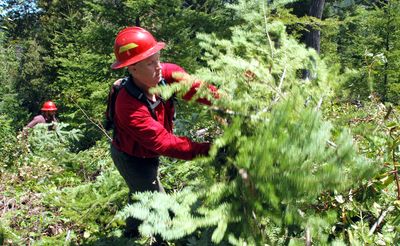Studies foresee dilemma over thinning of forests
Wildfire prevention hinders carbon storage potential

GRANTS PASS, Ore. – Scientists conclude in two government-funded studies that forests in the Pacific Northwest have a huge potential to store more carbon to combat global warming, but not if they are heavily thinned to prevent wildfire.
That poses a dilemma to the U.S. Forest Service, which has historically focused on balancing timber production against maintaining fish and wildlife habitat, but is increasingly trying to thin out young trees and brush to control wildfires that regularly cost $1 billion a year.
The stakes are big.
Globally, forests can absorb up to 30 percent of the carbon released by burning fossil fuels.
But when they are clearcut for lumber and to clear farmland, or allowed to burn uncontrollably, they also release huge amounts of carbon, said Steve Running, professor of ecology at the University of Montana and a lead author of the Intergovernmental Panel on Climate Change’s latest report on global warming.
“So forests could be a significant part of the solution or could make the problem worse,” said Running, who did not take part in either study. “I think this is going to be a very interesting challenge for forest ecosystem management over the next few decades, to see if we can develop a plan of walking the tightrope like this,” he said.
Robert Doudrick, Forest Service staff director for research and development, said the two studies offered valuable information to be considered as the Forest Service tries to keep its options open in the face of an uncertain future over climate and energy.
“Whether or not carbon is our primary responsibility has yet to be decided,” he said.
“Whether biomass supply and an energy future for our country will be more important than wildlife habitat are issues that are yet to be decided. We are required on every piece of property to make that sort of decision.”
The two studies from the Oregon State University Department of Forest Science appear in the journal Ecological Applications.
One of the studies, funded by the U.S. Department of Energy for the U.S. Carbon Cycle Program, examined the amount of biomass – living and dead trees and brush – on 9,000 test plots in Oregon and Northern California from a Forest Service inventory, plus 200 plots monitored by OSU.
It estimated that as long as the forests are not logged or burned, they have the potential to double the amount of carbon stored, though the prospects over the next 50 years are more like 15 percent.
Public forests account for 65 percent of the biomass, which continues to increase even when forests hit more than 300 years old.
The study did not factor in future fires or climate change.
The forests reach a maximum potential for storing carbon at 150 to 200 years old, said lead author Tara Hudiburg, a graduate student at OSU.
The other study, funded by NASA, used a computer simulation model to analyze thinning treatments on forests in Oregon’s Cascade and Coast ranges, and concluded that so many trees and brush have to be removed to significantly reduce the carbon lost to wildfires, that even more carbon is released into the atmosphere by thinning than when the forests burn.
“If you wanted to save one unit of carbon going up in the atmosphere in a fire, you had to remove 10 to 20 units of carbon to achieve that result,” said co-author Mark E. Harmon, professor of ecology at OSU.
The reason is that even in severe fires, the bulk of the carbon in the trunks, branches and roots of trees do not burn, so continues to be stored as carbon for many years, Harmon said.
The study suggested that forests where carbon storage is the primary purpose should not be thinned over the next 100 years.
“If we have to protect housing and infrastructures, by all means do (thinning). It isn’t about carbon stores,” Harmon said.